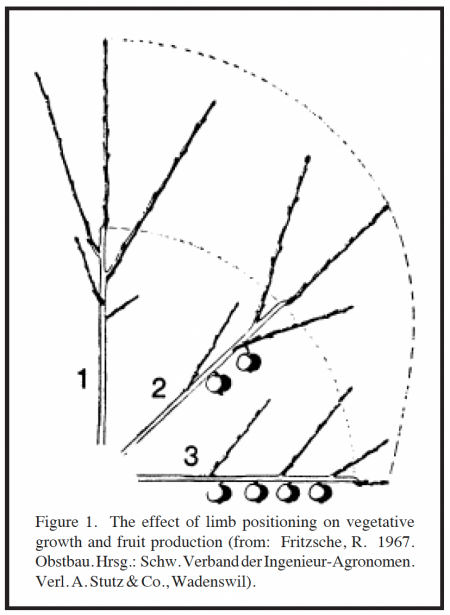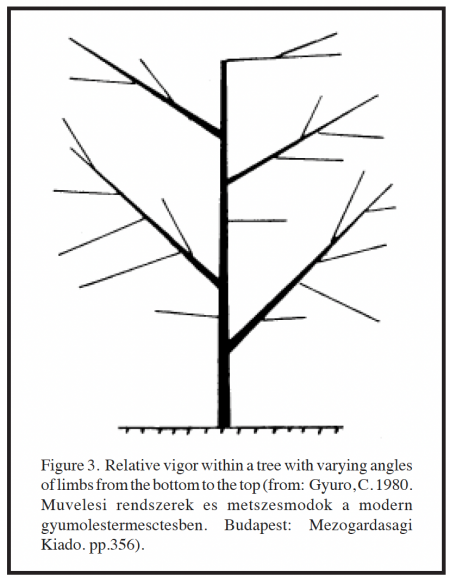
F-114R: Limb Positioning
Manipulating the relationship between vegetative growth and reproductive growth (fruit production) is key to successful fruit-tree management. Several aspects are integral to this relationship: orchard soil, fertilization, irrigation, rootstock, cultivar, tree age, tree spacing, pruning, etc. All tree-fruit growers are concerned with these factors and often attempt to manipulate them in such a way as to enhance productivity. As orchard intensification occurs, these factors and others which can alter the relationship between vegetative growth and fruit production become much more important.
One factor that can be important both to intensive treemanagement systems as well as less intensive systems is limb positioning, i.e. altering the angle of limbs originating at the central trunk. The angle of a limb has a local effect on vegetative growth and fruit production of that limb. Changing the orientation of a limb from vertical to horizontal reduces the terminal growth of the limb and increases flower bud formation. This relationship is depicted in Figure 1.
The reason for the change from vegetative growth to more reproductive growth relates partially to the dominance of the terminal bud on a limb and to the reallocation of nutrients and hormones. On a vertical limb, the terminal bud (the upper most bud) is dominant. It produces hormones called auxins which are translocated down the stem. This movement causes nutrients and carbohydrates to flow preferentially to the terminal bud, reducing both the vegetative and reproductive growth potential of lateral buds. When the limb is moved to horizontal, or closer to horizontal, the dominance of the terminal bud is reduced, because auxin production and translocation of auxins from it are reduced. The result is a more even distribution of nutrients and carbohydrates within the whole limb, allowing vegetative and reproductive growth to occur throughout the limb.
How can limb positioning help manage the vigor and productivity of an apple tree? Simply, nonproductive, overly vigorous limbs can be moved to a more horizontal position to enhance productivity and reduce growth, and nonvigorous, overly productive limbs can be moved to a more vertical position to enhance growth and reduce productivity.
Relationship of Limb Angle and Position within the Tree
If all limbs within a tree were trained to the same angle, those at the top of the tree would have more vigor and overgrow those at the bottom (Figure 2). If a great deal of limb positioning is done within a tree, care must be taken to avoid reducing the vigor of the bottom of the tree more than the top, so in general, angles from vertical should be greater at the top of the tree than at the bottom (Figure 3).
Techniques of Limb Positioning
There are nearly as many techniques of limb positioning as there are practitioners; however, there are some general categories of techniques. Probably the most commonly used method of limb positioning is spreading. Wooden, plastic, or metal devices are used which force limbs downward (Figure 4A). The advantage of this technique is that the limb is positioned solidly and in its final position. For this technique to work well, however, limbs must be relatively vigorous initially so that there is adequate force between the central trunk and the limb to hold the spreader in place. Furthermore, it is difficult to spread limbs below horizontal or to spread limbs near the top of the tree, and it is impossible to move limbs closer to vertical.
A second common method of limb positioning is the use of weights hung on limbs (Figure 4B). Many types of weights are used. Any limb in the tree can be positioned with this technique. Stronger limbs require heavier weights. This method is very easy to use, but it does not place the limb in its final position. Since a weight provides a constant force, limbs can be moved too far from vertical if weights are not checked regularly and repositioned when necessary. As with spreaders, it is impossible to move limbs closer to vertical.
The third general method of limb positioning is tying (Figure 4C). Various means of tying are used, but basically, a limb is pulled into the desired position, either up or down, by tying it to a permanent support. Care must be taken to loop the tying material around the limb in such a way as not to girdle it. This method is more labor intensive, but is a very reliable method for positioning a limb at any angle.
Timing of Limb Positioning
Little is know about the best timing for limb positioning. In Europe, most limb positioning is done after terminal growth has ceased (near July 1). This timing should result in no watersprouts developing from the upper portion of horizontally positioned limbs; however, it likely will have no effect on flower bud formation for next year’s crop. On the other hand, limbs positioned to near horizontal in May likely will produce water sprouts but also may set more flower buds for next year. If limb invigoration is the goal, clearly, the earlier in the growing season the better. If relatively weak limbs set fruit and begin to bend from the weight, tying them up as soon as possible is best.
Limb positioning is a very effective technique for controlling limb growth and productivity. It must be used with care and will be a very important technique for managing high density orchards.



